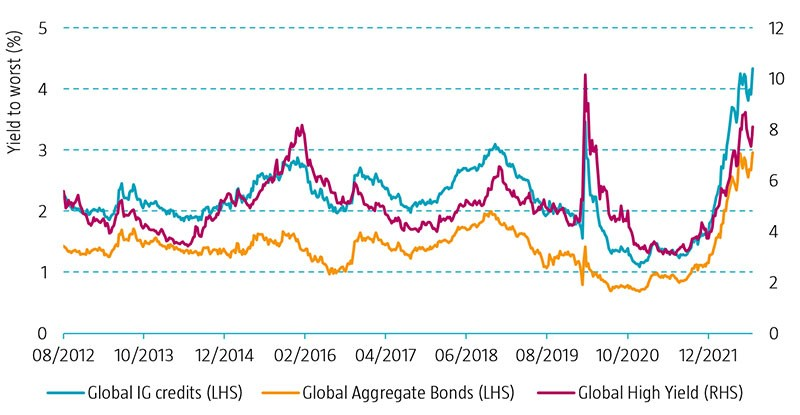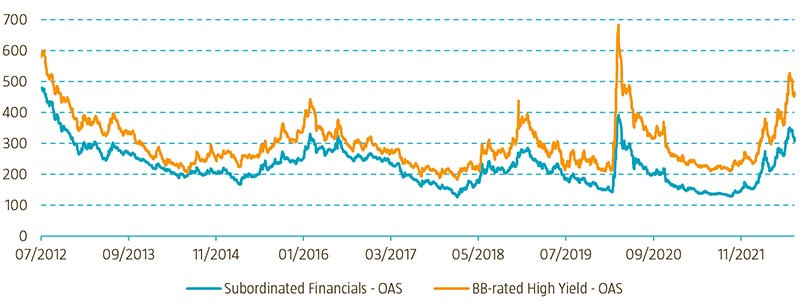The first half of 2022 was the worst period for fixed income since 1788, if we take the US treasury market as a proxy. Global bond markets have undergone a very significant repricing so far this year, with higher interest rates and wider credit spreads. But, nominal bond yields for the various fixed income asset classes are now at levels not seen in a decade. With the rise in yields, the opportunity to generate higher income over the coming years has increased substantially. As a result, bonds are becoming an attractive alternative to other asset classes. Their added benefit is that they have much lower volatility than equities. Bonds are again starting to behave as bonds typically do.
Diversification is key
Bond returns were negative in the first half of 2022, alongside negative returns over this period from riskier asset classes like equities. But history shows that, at times such as these, we can expect bonds to start behaving as a hedge to equities again. At current yield levels, bonds are able to absorb further yield rises before total returns from the asset class become more negative again.
For example, a portfolio of high-quality short-maturity fixed income bonds currently delivers a yield of 3.9% with a duration of 3 years (source: Bloomberg Global Agg Corp 1-5 years). It would take a yield rise of approximately 130 bps before total returns start to become negative again. While for the longer-duration portfolios the sensitivity to rising yields is higher, the increased yield cushion has materially improved break-evens.
There are other reasons why we think bonds will behave as bonds again, and provide diversification against equity market volatility.
As much as bonds hate inflation, they love recessions. Historically, bonds have outperformed equities in a recession. Recession risks are more elevated today compared to a year ago, which should be more supportive for bond prices while potentially being negative for equity prices. Thus, bonds could go back to being a diversifier in an environment of weaker economic growth.
History shows that bonds have been a good diversifier to equities. For example, in years with negative equity returns such as 1992, the period 2000-2002, 2008 and 2018, bond prices rose (source: MSCI World and Bloomberg Global Aggregate Bond Index, USD hedged), providing diversification in a challenging environment for equities. Even so far in 2022 (the year to 31 July), while equities suffered a drawdown of 14%, bond returns declined by a more tempered 6.7%, showing that bonds have a role in limiting volatility even when they decline at the same time as equities.
Figure 1 | Global bond yields

Bond yields now at or approaching peak levels not seen in last 10 years
Source: Bloomberg, Robeco
Bonds are back to providing income
Aside from the diversification benefits that bonds can provide, investors also recognize their income-generating ability and have historically allocated to this asset class to benefit accordingly. Typically, the yield is the most important determinant of longer-term bond returns, but in the low and even negative yield environment experienced in recent years, capital gains were the more important driver of fixed income returns.
The good news is that, with the rise in yields, bonds are back to providing income for investors and yields will again be a dominant driver of fixed income returns. Higher yields now mean higher income for bond investors in the future. While yields on government bonds are starting to look attractive, credit spreads have also widened substantially and now offer a more compelling compensation for credit risk. This compensation is warranted in light of heightened recession risk and tighter financial conditions. It is not yet clear whether inflation will come down meaningfully and fast.
With more uncertainty ahead, we believe that high-quality credit investments with a low risk of default offer good value for investors. In our view, bank and insurance debt looks cheap and cross-over credit (BB/BBB) offers appealing investment opportunities, too.
Figure 2 | Spreads Euro Subordinated Financials and European BB-rated High Yield

Credit spreads at attractive levels
Source: Bloomberg, Robeco
重要事項
当資料は情報提供を目的として、Robeco Institutional Asset Management B.V.が作成した英文資料、もしくはその英文資料をロベコ・ジャパン株式会社が翻訳したものです。資料中の個別の金融商品の売買の勧誘や推奨等を目的とするものではありません。記載された情報は十分信頼できるものであると考えておりますが、その正確性、完全性を保証するものではありません。意見や見通しはあくまで作成日における弊社の判断に基づくものであり、今後予告なしに変更されることがあります。運用状況、市場動向、意見等は、過去の一時点あるいは過去の一定期間についてのものであり、過去の実績は将来の運用成果を保証または示唆するものではありません。また、記載された投資方針・戦略等は全ての投資家の皆様に適合するとは限りません。当資料は法律、税務、会計面での助言の提供を意図するものではありません。 ご契約に際しては、必要に応じ専門家にご相談の上、最終的なご判断はお客様ご自身でなさるようお願い致します。 運用を行う資産の評価額は、組入有価証券等の価格、金融市場の相場や金利等の変動、及び組入有価証券の発行体の財務状況による信用力等の影響を受けて変動します。また、外貨建資産に投資する場合は為替変動の影響も受けます。運用によって生じた損益は、全て投資家の皆様に帰属します。したがって投資元本や一定の運用成果が保証されているものではなく、投資元本を上回る損失を被ることがあります。弊社が行う金融商品取引業に係る手数料または報酬は、締結される契約の種類や契約資産額により異なるため、当資料において記載せず別途ご提示させて頂く場合があります。具体的な手数料または報酬の金額・計算方法につきましては弊社担当者へお問合せください。 当資料及び記載されている情報、商品に関する権利は弊社に帰属します。したがって、弊社の書面による同意なくしてその全部もしくは一部を複製またはその他の方法で配布することはご遠慮ください。 商号等: ロベコ・ジャパン株式会社 金融商品取引業者 関東財務局長(金商)第2780号 加入協会: 一般社団法人 日本投資顧問業協会

